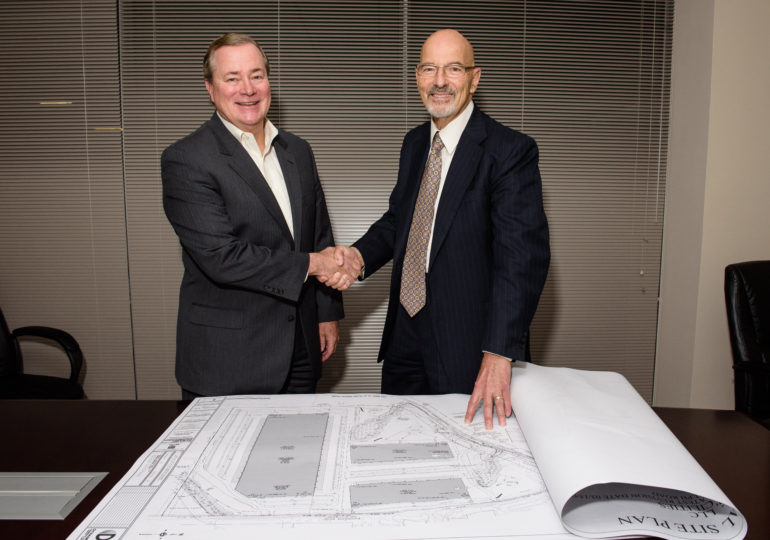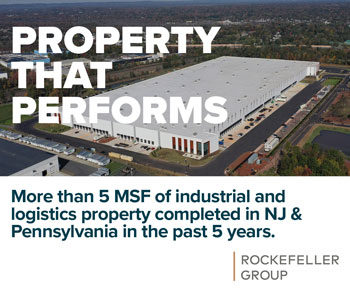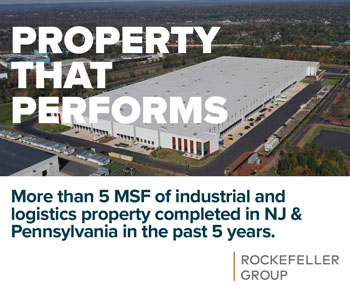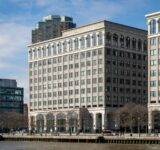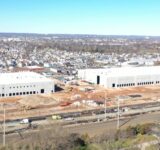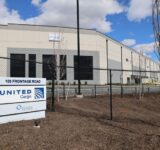Jeff Milanaik (left), regional partner with Bridge Development Partners in New Jersey, joined Paul Profeta, owner and president of Paul V. Profeta & Associates, at Bridge’s office in Parsippany to discuss their recent transaction in Franklin. — Photo by Jeffrey Vock for Real Estate NJ
(Editor’s note: Paul V. Profeta & Associates is owned by Paul Profeta, who is the publisher of Real Estate NJ)
By Joshua Burd
Jeff Milanaik vowed that Bridge Development Partners would double down in New Jersey.
It wasn’t just a figure of speech. Heading into the second half of 2018, Bridge has taken several key steps toward refilling its pipeline of industrial projects in the Garden State. That includes some 6 million square feet of big-box, infill developments in high-barrier locations, all meant to capture the unrelenting demand for distribution space from ecommerce players and other users.
The developer is now planning a three-building, 1.7 million-square-foot project in the Somerset section of Franklin after acquiring two parcels at Weston Canal Road and Randolph Road. Bridge closed on the sites earlier this month in separate deals with Paul V. Profeta & Associates and Russo Development, Milanaik said, adding that he now hopes to break ground later this summer and deliver the properties by mid-2019.
Sitting on a combined 129 acres, the complex will be anchored by a roughly 1.1 million-square-foot building that Milanaik called a “game-changer,” given that spaces of that size are increasingly scarce in the region.
“When you step back and look at that product, it doesn’t exist, because where is a million-footer going to go right now?” Milanaik said. “With the demand in the marketplace, within the next 18 to 24 months, where are the big buildings? They’re not there.”
The Franklin site will be part of a fast-growing submarket along Interstate 287, as landlords struggle to find new sites along the New Jersey Turnpike. The area was never considered a premier destination for industrial users, Milanaik said, but the I-287 submarket has been validated recently by interest from leading developers and deals with high-profile tenants.
Chief among them was Best Buy’s 725,000-square-foot lease at 171 River Road in Piscataway, part of a 2.2 million-square-foot complex under construction by the Rockefeller Group. The strong activity made the submarket increasingly attractive for Bridge, which saw an opportunity to assemble a larger site as he engaged Profeta and Russo in separate negotiations.
“In and of itself, it wasn’t going to give me the critical mass I wanted to do out there,” said Milanaik, a veteran developer in the state. “I needed to put something here to differentiate myself from every other 100,000- or 200,000-foot building. So I didn’t know what that meant, but I knew I had to do that.”
Thomas Nuara of Resource Realty brokered the transaction between Profeta and Bridge.
The effort comes less than a year after Bridge, a Chicago-based firm, completed a three-state, 10-property portfolio sale to Duke Realty Corp. The deal was worth nearly $700 million and was anchored by 3.1 million square feet of newly built or soon-to-be-completed space in New Jersey, which quickly put Bridge on the map after it opened an office here in 2014.
Milanaik and his team have moved quickly to line up other projects in the state.
The firm acquired a 380-acre site in Warren County — straddling Phillipsburg and Lopatcong — that is approved for 3.8 million square feet of warehouse and distribution space. Sitting directly on Route 22, the property is just a few miles from Interstate 78 and near the border of Pennsylvania’s Lehigh Valley, a region that has drawn interest from New Jersey developers in recent years.
Bridge acquires I-78 industrial site with approvals for 3.8 million sq. ft.
Many of those firms, including Bridge, have seen the eastern Lehigh Valley as an alternative to the Exit 8A submarket, which is home to regional distribution centers for many large users. Milanaik said the submarkets have been comparable when it comes to labor, rental rates and other metrics. And he now sees both as infill markets for new projects.
“It’s more like 8A, where if you really spend time at 8A, despite seeing all the green, there really is no land left but for a few property owners,” he said. “You have the same condition exactly in the Lehigh Valley right now. It’s really difficult to come across a piece of property.”
The Warren County site was home to an Ingersoll Rand plant that the company vacated more than 20 years ago. Plans to reposition the property never materialized despite attracting several developers, including Opus Investments/KTV Inc., which spent three years razing old buildings and securing approvals, before opting to sell the property to Bridge early this year.
Bridge is now finalizing site plans for its first four buildings, a 975,000-square-foot project in Lopatcong and three in Phillipsburg totaling nearly 1.3 million square feet, Milanaik said. The firm hopes to begin construction on all four by the end of the year, while the balance of the site is still being remediated by Ingersoll Rand.
“The towns really encouraged and wanted the development because they’re anxious to create the jobs for that region, so the labor supply is terrific,” Milanaik said, noting that the municipalities are offering tax abatements. What’s more, being east of the Delaware River preserves the potential for state incentives, while allowing tenants to be even closer to Port Newark-Elizabeth.
Bridge is also working on the second phase of a major redevelopment project in Perth Amboy, just north of a 1.3 million-square-foot complex that was included in the sale to Duke. Like the first phase, the site requires an extensive environmental cleanup before the firm can begin construction on another 1 million square feet across two buildings.
Milanaik said he aims to complete that process and break ground by early next year at the 70-acre site. Meantime, the firm has approvals for a 125,000-square-foot project on Whitman Avenue in Edison, with the goal of starting construction this summer, along with several other prospective developments in northern and central New Jersey.
“We’re attracting other opportunities now because the brand is there,” Milanaik said. “The success does breed success at the end of the day.”
There are several common threads as the firm works through those opportunities. Along with its joint venture partner, Banner Oak Capital Partners, Bridge has the ability to be aggressive and move quickly in acquiring new development parcels.
That’s especially important, given the length of the current cycle, the unprecedented strength of the market and the uncertainty about just how much longer it will last.
The firm also finds itself with sites in towns that aspired to see redevelopment for years or decades, much like the former Ingersoll Rand site in Warren County. In those cases, Milanaik said one of the biggest challenges “is to create the assurance with the town” that Bridge will succeed where other developers have not.
The firm’s success of the last four years goes a long way in creating those assurances.
“And it doesn’t sound like much, but a lot of these towns have seen people come and people go, and we’re proud to be able to point to our track record of dealing with some of the most complicated sites,” he said. “With our capital structure and our desire to move forward and our technical ability, we know we’re going forward, but there’s a lot of skepticism in these towns until they see the shovel in the ground.”
(Editor’s note: Paul V. Profeta & Associates is owned by Paul Profeta, who is also the publisher of Real Estate NJ.)
Fundamentally sound
If the first quarter of 2018 was any indication, industrial developers in New Jersey can’t build quickly enough.
Vacancy in northern and central New Jersey fell to 3.4 percent in the first three months of the year, according to research from JLL, amid overwhelming demand for logistics space. But leasing velocity slowed to 5.3 million square feet during the quarter — a three-year low — because of a lack of big-box availabilities in the region.
By the end of Q1, JLL found that there were just four Class A and B buildings existing or under construction with more than 500,000 square feet available. Only one of those buildings was available for immediate occupancy.
But the market’s strong fundamentals are expected to continue, likely rewarding developers who deliver warehouse and distribution space in the coming months. JLL found that nine speculative projects totaling 3.5 million square feet were expected to break ground in the second quarter.
“Landlords are cognizant of the imbalance between supply and demand, so expect pricing on this new wave of product to be at high water mark levels, particularly in central and southern New Jersey,” JLL researchers wrote in their Q1 market report. “As a result, tenants should be prepared to pay a premium and act quickly to secure Class A facilities, as several tenants are likely to be looking at each availability.”

